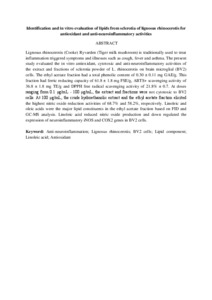Citation
Nallathamby, Neeranjini and Serm, Lee Guan and Raman, Jegadeesh and Abd Malek, Sri Nurestri and Vidyadaran, Sharmili and Naidu, Murali and Kuppusamy, Umah Rani and Sabaratnam, Vikineswary
(2016)
Identification and in vitro evaluation of lipids from sclerotia of lignosus rhinocerotis for antioxidant and anti-neuroinflammatory activities.
Natural Product Communications, 11 (10).
pp. 1485-1490.
ISSN 1934-578X; ESSN: 1555-9475
Abstract
Lignosus rhinocerotis (Cooke) Ryvarden (Tiger milk mushroom) is traditionally used to treat inflammation triggered symptoms and illnesses such as cough, fever and asthma. The present study evaluated the in vitro antioxidant, cytotoxic and anti-neuroinflammatory activities of the extract and fractions of sclerotia powder of L. rhinocerotis on brain microglial (BV2) cells. The ethyl acetate fraction had a total phenolic content of 0.30 ± 0.11 mg GAE/g. This fraction had ferric reducing capacity of 61.8 ± 1.8 mg FSE/g, ABTS+ scavenging activity of 36.8 ± 1.8 mg TE/g and DPPH free radical scavenging activity of 21.8% ± 0.7. At doses ranging from 0.1 μg/mL - 100 μg/mL, the extract and fractions were not cytotoxic to BV2 cells. At 100 μg/mL, the crude hydroethanolic extract and the ethyl acetate fraction elicited the highest nitric oxide reduction activities of 68.7% and 58.2%, respectively. Linoleic and oleic acids were the major lipid constituents in the ethyl acetate fraction based on FID and GC-MS analysis. Linoleic acid reduced nitric oxide production and down regulated the expression of neuroinflammatory iNOS and COX2 genes in BV2 cells.
Download File
![[img]](http://psasir.upm.edu.my/54477/1.hassmallThumbnailVersion/Identification%20and%20in%20vitro%20evaluation%20of%20lipids%20from%20sclerotia%20of%20lignosus%20rhinocerotis%20for%20antioxidant%20and%20anti-neuroinflammatory%20activities.pdf)  Preview |
|
Text
Identification and in vitro evaluation of lipids from sclerotia of lignosus rhinocerotis for antioxidant and anti-neuroinflammatory activities.pdf
Download (76kB)
| Preview
|
|
Additional Metadata
Actions (login required)
 |
View Item |

